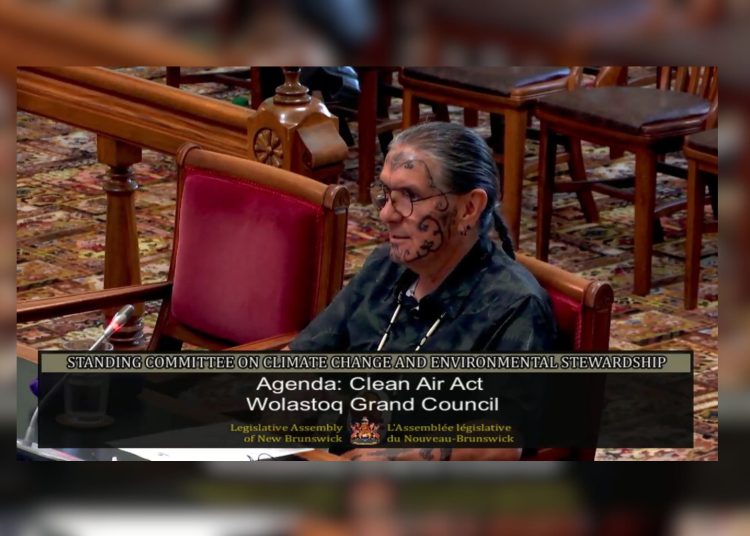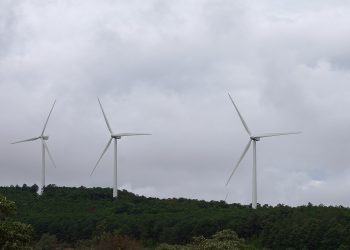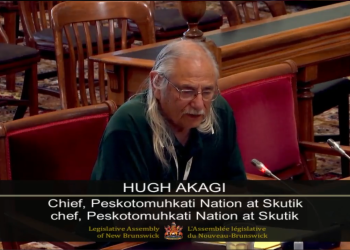September 7th marked the International Day of Clean Air for blue skies, a United Nations initiative to strengthen global cooperation in improving air quality and reducing pollution. It is a moment for all of us to reflect on the invisible threats in the air we breathe — and what can be done to protect our communities.
This year, the timing is especially significant for New Brunswick. The provincial legislature’s Standing Committee on Climate Change and Environmental Stewardship is holding hearings on the province’s Clean Air Act, a rare chance for citizens to demand stronger protections and ensure cleaner, healthier air for generations to come.
On September 9, Wolastoqey Grand Chief Ron Tremblay addressed the Standing Committee emphasizing that Air, Water, and Earth are sacred, life-giving beings that sustain all creation and must not be reduced to mere commodities. Chief Tremblay’s written submission stated, “Today, we recognize and resist the extensive abuses to Air, Water and Earth that resource industries and governments are unleashing, directly attacking Air, Water and Earth.” In his oral presentation, he urged all levels of government to respect Indigenous sovereignty and invited broader society to join the Wolastoq Grand Council efforts in protecting these sacred elements for future generations.
Compared to other OECD nations, Canada consistently ranks among the three worst industrialized countries for per capita emissions of sulphur dioxide, nitrogen dioxide, volatile organic compounds (VOCs), carbon monoxide, and greenhouse gases.
One major reason: weak air quality laws. Canada does not have legally binding national air quality standards. The David Suzuki Foundation described existing standards as “voluntary guidelines” that carry no legal consequences when they are not met. And even if these guidelines were consistently met, Canada’s requirements fall below international safety standards and lag behind the most recent scientific recommendations for protecting public health.
The result is ongoing high levels of pollution — and the heavy health and economic costs that come with it.
At the provincial level, New Brunswick has long taken a permissive stance toward pollutant industries. This includes the nuclear industry, which continues to market itself as “clean” and “green.”
In reality, the industry produces toxic radioactive emissions during reactor operation, and its waste products remain hazardous for millennia. In other parts of the country, the nuclear fuel cycle also contributes to air pollution through uranium mining, milling, and enrichment, releasing radioactive dust, heavy metals, and greenhouse gases.
Far from being harmless, exposure to radioactive pollutants has been linked to a wide range of serious health impacts. Studies have shown that radionuclide exposure can cause a range of serious health problems, from various types of cancer to birth defects, impaired brain development, organ damage, and chronic conditions affecting the heart, lungs, and immune system.
More recent studies of nuclear industry workers have revealed that even low-dose exposures carry far greater risks than previously understood — risks that also apply to nearby populations and wildlife.
Dr. Ian Fairlie, an expert on nuclear radiation, has raised significant health concerns regarding the Point Lepreau nuclear reactor in New Brunswick, particularly its unusually high emissions of radioactive tritium. Tritium is hazardous because it can bind with cellular components and persist in the body. At a public hearing on May 10, 2022, Rumina Velshi, then President of the Canadian Nuclear Safety Commission, confirmed that tritium releases from Point Lepreau had doubled between 2016 and 2022, emphasizing that these emissions are not merely fluctuating but are following a troubling upward trend.
Compared to other nuclear power plants in Canada, Lepreau’s tritium emissions are notably high — approximately four times greater than those from the Darlington site in Ontario. In fact, Canadian reactors as a whole emit more tritium than their counterparts in the U.S. or Europe. Despite this, Canada maintains relatively lenient safety standards for tritium exposure. In 2020 alone, Point Lepreau released 290 terabecquerels of tritium into the atmosphere.
Adding insult to injury, the nuclear industry also relies on burning fossil fuels, emitting greenhouse gases. In 2022 alone, the Point Lepreau Nuclear Generating Station reported that the plant burned over 4,000 barrels (650,469 liters) of diesel fuel for backup power and safety systems — another contributor to New Brunswick’s air pollution.
As Canada persists in pursuing nuclear energy, countries such as Germany and Denmark have shown that substantial reductions in air pollution and greenhouse gas emissions are attainable without it. In 2024, the European Union generated more electricity from solar power than from coal for the first time, marking a major milestone in the shift toward clean, renewable energy.
Meanwhile, Indigenous groups in Canada have long been raising the alarm about the dangers of nuclear power. They emphasize that nuclear reactors produce hazardous radioactive waste that remains toxic for millennia — waste for which we still do not have a safe, long-term storage solution. For many First Nations and Indigenous communities, the ongoing operation and expansion of nuclear facilities represent not only a threat to the Land, Air, and Water, but also a profound ethical concern: the potential harm that will be inherited by countless future generations.
Wolastoqey Grand Chief Ron Tremblay also addressed the Standing Committee on Climate Change and Environmental Stewardship in 2023, offering insight rooted in Indigenous wisdom. He explained that the mandate of the Wolastoq Grand Council requires asking three fundamental questions of any proposed development project: (1) Will it bring harm to the Earth, Water, or Air? (2) Will it cause irreversible consequences? and (3) Will it affect the next seven generations of our Nation? By this standard, continuing with nuclear power generation or pursuing any form of nuclear development is a clear “yes” to all three questions.
More recently, Peskotomuhkati Chief Hugh Akagi wrote a letter to the Standing Committee recommending, among other things, that they include radionuclides as a contaminant toxic of concern in the revised Act and that they set stricter, science-based emissions standards for industrial sources.
The International Day of Clean Air reminds us that we share a common atmosphere and a common responsibility. With New Brunswick’s Clean Air Act under review, now is the time for citizens to raise their voices.
We can demand that our province take decisive action to protect public health and the environment. This includes strengthening air quality laws by establishing legally binding standards, holding polluting industries accountable for their emissions, and rejecting the myth of “clean nuclear”
in favor of investing in genuinely clean, renewable energy alternatives.
Clean air is not a privilege — it is a human right. Let us not allow weak laws and misleading claims to cloud our skies or compromise our health.
Mayara Gonçalves e Lima works with the Passamaquoddy Recognition Group Inc., focusing on nuclear energy. Their work combines environmental advocacy with efforts to ensure that the voice of the Passamaquoddy Nation is heard and respected in decisions that impact their land, waters, and future.


![Radioactivity and nuclear waste under scrutiny in Peskotomuhkati homeland [video]](https://nbmediacoop.org/wp-content/uploads/2025/10/EdwardsAkagiOct52025-1-350x250.jpg)



![‘Continuum of genocide’: Pentagon funding of Sisson mine provokes renewed opposition from Wolastoq Elders [video]](https://nbmediacoop.org/wp-content/uploads/2025/07/SissonMine-2-120x86.jpg)



